UAV-Assisted Low-Consumption Time Synchronization Utilizing Cross-Technology Communication
Abstract
1. Introduction
- We present a novel UAV-assisted low-consumption time synchronization algorithm for a large-scale wireless sensor network that can achieve time synchronization with almost zero energy consumption.
- We provide a method of sending time synchronization data packets based on CTC. It uses a general commercial high-power WiFi device to broadcast time synchronization data packets to ensure that the UAV can achieve time synchronization universally and quickly.
- We implemented and evaluated the UAV-TS method with a sparse development sensor network (30 CC2430 ZigBee nodes) and a DJI M100 UAV (equipped with a WiFi device). Numerous experimental results demonstrate the effectiveness of our algorithm.
2. Related Work
2.1. Time Synchronization
2.2. Cross-Technology Communication
3. Algorithm Overview
- The channel coding module encodes the data bits in the WiFi frame into redundant coded bits to enhance the robustness of the data. Map these coded bits to a series of constellation points through quadrature amplitude modulation (QAM). The QAM process formula is expressed as follows:where and are two original signals and and are their corresponding quadrature modulation component.
- By using orthogonal frequency division multiplexing (OFDM) to insert pseudo-random pilot symbols, these constellation points are modulated into 48 data subcarriers. Meanwhile, pseudo-random pilot symbols are modulated into pilot subcarriers for channel estimation. The OFDM process formula is expressed as follows:where is the number of subcarriers, is the preset carrier frequency interval, and and are different k-channel modulated subcarrier signals.
- After the subcarriers are processed by inverse fast Fourier transform (IFFT), all the subcarriers are combined and converted into a ZigBee time domain signal. As the following formula:
- The ZigBee time domain signal is processed by a cyclic prefix module to form a cyclic prefix with an interval of 0.8 μs to eliminate inter-symbol interference and generate a simulated ZigBee signal.
- Finally, encapsulate the simulated ZigBee signal into the payload of the WiFi data packet and send the WiFi data packet.
- The transmission bandwidth of WiFi and ZigBee have overlapping parts, and this overlapping part can be used as a communication channel. At the same time, the transmission distance of WiFi can reach several hundred meters, which is much larger than the transmission distance of low-power ZigBee so it can cover a broader range. It means that using WiFi node as reference point has a certain theoretical basis, strong signal strength, and wide coverage.
- Modified the data packet format, so that the ZigBee receiver can more easily receive the simulated time synchronization data packet. Compared with the general ZigBee network, ZigBee nodes as receivers are only used to receive data and do not require extra energy to send data.
4. Algorithm Design
4.1. Analysis of Existing Problems of Physical-Level CTC
4.2. Analysis of the FTSP Packet
4.3. Simulated Time Synchronization Data Packet
4.4. Clock Deviation Modification
5. Algorithm Evaluation
5.1. Experimental Setup
5.2. Evaluation of Delay
5.3. Evaluation of Packet Reception Rate
5.4. Evaluation of Energy Consumption
6. Conclusions
Author Contributions
Funding
Conflicts of Interest
References
- Wang, J.; Zhao, R.; Gu, W. Time Synchronization in Networks: A Survey. In Proceedings of the 2nd International Conference on Control and Computer Vision, Jeju Island, Korea, 25 April 2019; pp. 121–126. [Google Scholar]
- Liang, C.J.M.; Chen, K.; Priyantha, N.B.; Liu, J.; Zhao, F. Rushnet: Practical traffic prioritization for saturated wireless sensor networks. In Proceedings of the 12th ACM Conference on Embedded Network Sensor Systems, Memphis, TN, USA, 3–6 November 2014; pp. 105–118. [Google Scholar]
- Hao, T.; Zhou, R.; Xing, G.; Mutka, M.W.; Chen, J. Wizsync: Exploiting wi-fi infrastructure for clock synchronization in wireless sensor networks. IEEE Trans. Mob. Comput. 2013, 13, 1379–1392. [Google Scholar]
- Adhatarao, S.S.; Arumaithurai, M.; Kutscher, D.; Fu, X. ISI: Integrate sensor networks to Internet with ICN. IEEE Internet Things J. 2017, 5, 491–499. [Google Scholar] [CrossRef]
- Schmid, T.; Charbiwala, Z.; Anagnostopoulou, Z.; Srivastava, M.B.; Dutta, P. A case against routing-integrated time synchronization. In Proceedings of the 8th ACM Conference on Embedded Networked Sensor Systems, Zurich, Switzerland, 3–5 November 2010; pp. 267–280. [Google Scholar]
- Zhai, L.; Zhang, X.; Xie, G. Performance analysis of non-saturated IEEE 802.11 DCF networks. IEICE Trans. Commun. 2012, 95, 2509–2512. [Google Scholar] [CrossRef]
- Zhong, Z.; Chen, P.; He, T. On-demand time synchronization with predictable accuracy. In Proceedings of the International Conference on Computer Communications, Mumbai, India, 28–29 January 2011; pp. 2480–2488. [Google Scholar]
- Kawabata, S.; Matsuzaki, R.; Ebara, H. Mixed synchronous and asynchronous duty-cycling protocol in sensor networks. In Proceedings of the 48th International Conference on Parallel Processing: Workshops, Kyoto, Japan, 5 August 2019; pp. 1–7. [Google Scholar]
- Zhai, L.; Zhang, X. Modified 802.11-based opportunistic spectrum access in cognitive radio networks. ETRI J. 2012, 34, 276–279. [Google Scholar] [CrossRef]
- Zhai, L.; Xie, G. A slot-based opportunistic spectrum access for cognitive radio networks. IEICE Trans. Commun. 2011, 94, 3183–3185. [Google Scholar] [CrossRef]
- Hong, J.; Li, Z.; Lu, D.; Lu, S. Sleeping schedule-aware local broadcast in wireless sensor networks. Int. J. Distrib. Sens. Netw. 2013, 9, 451970. [Google Scholar] [CrossRef]
- Kim, H.; Ishikawa, M.; Yamakawa, Y. Reference broadcast frame synchronization for distributed high-speed camera network. In Proceedings of the 2018 IEEE Sensors Applications Symposium (SAS), Seoul, Korea, 12–14 March 2018; pp. 1–5. [Google Scholar]
- Ganeriwal, S.; Pöpper, C.; Čapkun, S.; Srivastava, M.B. Secure time synchronization in sensor networks. ACM Trans. Inf. Syst. Secur. 2008, 11, 1–35. [Google Scholar] [CrossRef]
- Ganeriwal, S.; Kumar, R.; Srivastava, M. Timing-sync protocol for sensor networks. In Proceedings of the 1st International Conference on Embedded Networked Sensor Systems, Los Angeles, CA, USA, 5–7 November 2003; pp. 138–149. [Google Scholar]
- Mohammadmoradi, H.; Gnawali, O.; Rattner, N.; Terzis, A.; Szalay, A. Robust time synchronization in wireless sensor networks using real time clock. In Proceedings of the 12th ACM Conference on Embedded Network Sensor Systems, Memphis, TN, USA, 3–4 November 2014; pp. 356–357. [Google Scholar]
- Sattar, D.; Sheltami, T.R.; Mahmoud, A.S.H.; Shakshuki, E.M. A Comparative Analysis of Flooding Time Synchronization Protocol and Recursive Time Synchronization Protocol. In Proceedings of the International Conference on Advances in Mobile Computing & Multimedia; Association for Computing Machinery: New York, NY, USA, 2013; pp. 151–155. [Google Scholar]
- Fotedar, N.; Saini, P. An Energy Efficient Algorithm for Time Synchronization in Sensor Networks. In Proceedings of the International Conference on High Performance Compilation, Computing and Communications, Kuala Lumpur, Malaysia, 15 November 2017; pp. 91–96. [Google Scholar]
- Aoun, M.; Schoofs, A.; van der Stok, P. Efficient time synchronization for wireless sensor networks in an industrial setting. In Proceedings of the 6th ACM Conference on Embedded Network Sensor Systems, Raleigh, NC, USA, 5–7 November 2008; pp. 419–420. [Google Scholar]
- Lenzen, C.; Sommer, P.; Wattenhofer, R. Optimal clock synchronization in networks. In Proceedings of the 7th ACM Conference on Embedded Networked Sensor Systems, Berkeley, CA, USA, 4–6 November 2009; pp. 225–238. [Google Scholar]
- Pottie, G.J.; Kaiser, W.J. Wireless Integrated Network Sensors. Commun. ACM 2000, 43, 51–58. [Google Scholar] [CrossRef]
- Villas, L.A.; Guidoni, D.L.; Maia, G.; Pazzi, R.W.; Ueyama, J.; Loureiro, A.A.F. An Energy Efficient Joint Localization and Synchronization Solution for Wireless Sensor Networks using Unmanned Aerial Vehicle. Wirel. Netw. 2015, 21, 485–498. [Google Scholar] [CrossRef]
- Li, Z.; Xie, Y.; Li, M.; Jamieson, K. Recitation: Rehearsing wireless packet reception in software. In Proceedings of the 21st Annual International Conference on Mobile Computing and Networking, Los Cabos, Mexico, 21–25 October 2015; pp. 291–303. [Google Scholar]
- Zheng, X.; Cao, Z.; Wang, J.; He, Y.; Liu, Y. Zisense: Towards interference resilient duty cycling in wireless sensor networks. In Proceedings of the 12th ACM Conference on Embedded Network Sensor Systems, Memphis, TN, USA, 3–6 November 2014; pp. 119–133. [Google Scholar]
- Dhivvya, J.; Rao, S.N.; Simi, S. Towards maximizing throughput and coverage of a novel heterogeneous maritime communication network. In Proceedings of the 18th ACM International Symposium on Mobile Ad Hoc Networking and Computing, Chennai, India, 10–14 July 2017; pp. 1–2. [Google Scholar]
- Zheng, X.; He, Y.; Guo, X. Stripcomm: Interference-resilient cross-technology communication in coexisting environments. In Proceedings of the IEEE INFOCOM 2018—IEEE Conference on Computer Communications, Honolulu, HI, USA, 16–19 April 2018; pp. 171–179. [Google Scholar]
- Jin, T.; Noubir, G.; Sheng, B. Wizi-cloud: Application-transparent dual zigbee-wifi radios for low power internet access. In Proceedings of the 2011 Proceedings IEEE INFOCOM, Shanghai, China, 10–15 April 2011; pp. 1593–1601. [Google Scholar]
- Jiang, W.; Kim, S.M.; Li, Z.; He, T. Achieving Receiver-Side Cross-Technology Communication with Cross-Decoding. In Proceedings of the 24th Annual International Conference on Mobile Computing and Networking; Association for Computing Machinery: New York, NY, USA, 2018; pp. 639–652. [Google Scholar]
- Wang, W.; Xie, T.; Liu, X.; Zhu, T. ECT: Exploiting Cross-Technology Concurrent Transmission for Reducing Packet Delivery Delay in IoT Networks. In Proceedings of the IEEE INFOCOM 2018—IEEE Conference on Computer Communications, Honolulu, HI, USA, 16–19 April 2018; pp. 369–377. [Google Scholar]
- Jiang, W.; Yin, Z.; Kim, S.M.; He, T. Transparent cross-technology communication over data traffic. In Proceedings of the IEEE INFOCOM 2017—IEEE Conference on Computer Communications, Atlanta, GA, USA, 1–4 May 2017; pp. 1–9. [Google Scholar]
- Qiu, J.; Sun, K.; Rudas, I.J.; Gao, H. Command filter-based adaptive NN control for MIMO nonlinear systems with full-state constraints and actuator hysteresis. IEEE Trans. Cybern. 2019, 50, 2905–2915. [Google Scholar] [CrossRef] [PubMed]
- Qiu, J.; Sun, K.; Wang, T.; Gao, H. Observer-based fuzzy adaptive event-triggered control for pure-feedback nonlinear systems with prescribed performance. IEEE Trans. Fuzzy Syst. 2019, 27, 2152–2162. [Google Scholar] [CrossRef]
- Eidson, J.; Lee, K. IEEE 1588 standard for a precision clock synchronization protocol for networked measurement and control systems. In Proceedings of the 34th Annual Precise Time and Time Interval Systems and Applications Meeting, Reston, VA, USA, 3–5 December 2002; pp. 98–105. [Google Scholar]
- Huang, D.; Teng, W.; Yang, K. Secured flooding time synchronization protocol with moderator. Int. J. Commun. Syst. 2013, 26, 1092–1115. [Google Scholar] [CrossRef]
- Chebrolu, K.; Dhekne, A. Esense: Communication through energy sensing. In Proceedings of the ACM MobiCom, London, UK, 21–25 September 2009; pp. 85–96. [Google Scholar]
- Guo, X.; He, Y.; Zheng, X.; Yu, L.; Gnawali, O. ZIGFI: Harnessing Channel State Information for Cross-Technology Communication. In Proceedings of the IEEE INFOCOM, Honolulu, HI, USA, 16–19 April 2018; pp. 360–368. [Google Scholar]
- Kim, S.M.; He, T. FreeBee: Cross-technology Communication via Free Side-channel. In Proceedings of the ACM MobiCom, Paris, France, 7–11 September 2015; pp. 317–330. [Google Scholar]
- Li, Z.; Yin, Z.; Liu, L.; Liu, R.; He, T. Demo: WEBee: Physical-Layer Cross-Technology Communication via Emulation. In Proceedings of the 23rd Annual International Conference on Mobile Computing and Networking, Snowbird, UT, USA, 16–20 October 2017; pp. 493–494. [Google Scholar]
- Chi, Z.; Huang, Z.; Yao, Y.; Xie, T.; Sun, H.; Zhu, T. EMF: Embedding multiple flows of information in existing traffic for concurrent communication among heterogeneous IoT devices. In Proceedings of the IEEE INFOCOM 2017—IEEE Conference on Computer Communications, Atlanta, GA, USA, 1–4 May 2017; pp. 1–9. [Google Scholar]
- Yin, Z.; Jiang, W.; Kim, S.M.; He, T. C-morse: Cross-technology communication with transparent morse coding. In Proceedings of the IEEE INFOCOM 2017—IEEE Conference on Computer Communications, Atlanta, GA, USA, 1–4 May 2017; pp. 1–9. [Google Scholar]
- Jiang, W.; Yin, Z.; Liu, R.; Li, Z.; Kim, S.M.; He, T. Bluebee: A 10,000x faster cross-technology communication via phy emulation. In Proceedings of the 15th ACM Conference on Embedded Network Sensor Systems, Delft, The Netherlands, 21 November 2017; pp. 1–13. [Google Scholar]
- Guo, X. Cross Technology Communication in Heterogeneous Wireless Networks; EWSN: Matthews, NC, USA, 2019; pp. 312–313. [Google Scholar]
- Chi, Z.; Li, Y.; Sun, H.; Yao, Y.; Zhu, T. Concurrent Cross-Technology Communication among Heterogeneous IoT Devices. IEEE/ACM Trans. Netw. 2019, 27, 932–947. [Google Scholar] [CrossRef]
- Maróti, M.; Kusy, B.; Simon, G.; Lédeczi, Á. The flooding time synchronization protocol. In Proceedings of the 2nd International Conference on Embedded Networked Sensor Systems, Baltimore MD USA, 3–5 November 2004; pp. 39–49. [Google Scholar]
- Lenzen, C.; Sommer, P.; Wattenhofer, R. PulseSync: An efficient and scalable clock synchronization protocol. IEEE/ACM Trans. Netw. 2014, 23, 717–727. [Google Scholar] [CrossRef]
- Masood, W.; Schmidt, J.F. Autoregressive integrated model for time synchronization in wireless sensor networks. In Proceedings of the 18th ACM International Conference on Modeling, Analysis and Simulation of Wireless and Mobile Systems, Cancun, Mexico, 1 July 2015; pp. 133–140. [Google Scholar]
- Hu, A.S.; Servetto, S.D. Asymptotically optimal time synchronization in dense sensor networks. In Proceedings of the 2nd ACM International Conference on Wireless Sensor Networks and Applications, San Diego, CA, USA, 19 September 2003; pp. 1–10. [Google Scholar]
- Huang, W.; Quan, Y.; Chen, D. Improving broadcast efficiency in wireless sensor network time synchronization protocols. In Proceedings of the International Workshop on System Level Interconnect Prediction, San Francisco, CA, USA, 3 June 2012; pp. 48–55. [Google Scholar]
- Kawagoe, H.; Sugano, M. Implementation of Time Synchronization for Energy Harvesting Wireless Sensor Network. In Proceedings of the 2017 VI International Conference on Network, Communication and Computing, Kunming, China, 8–10 December 2017; pp. 175–178. [Google Scholar]
- Elson, J.; Girod, L.; Estrin, D. Fine-grained network time synchronization using reference broadcasts. ACM SIGOPS Oper. Syst. Rev. 2002, 36, 147–163. [Google Scholar] [CrossRef]
- Esfahani, N.P.; Cerpa, A.E. Poster: Energy optimization framework in wireless sensor network. In Proceedings of the 13th ACM Conference on Embedded Networked Sensor Systems, Seoul, Korea, 1 November 2015; pp. 441–442. [Google Scholar]
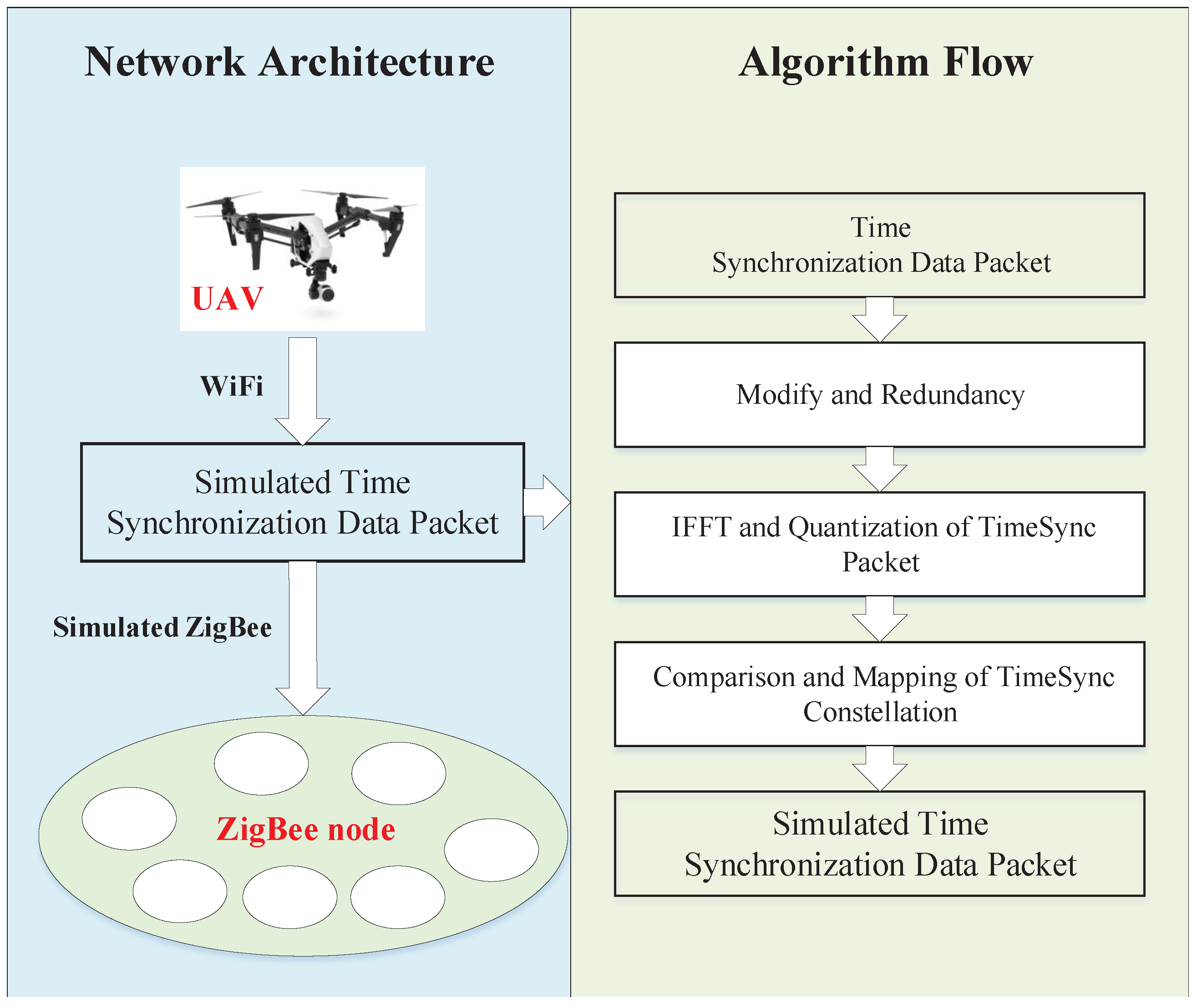


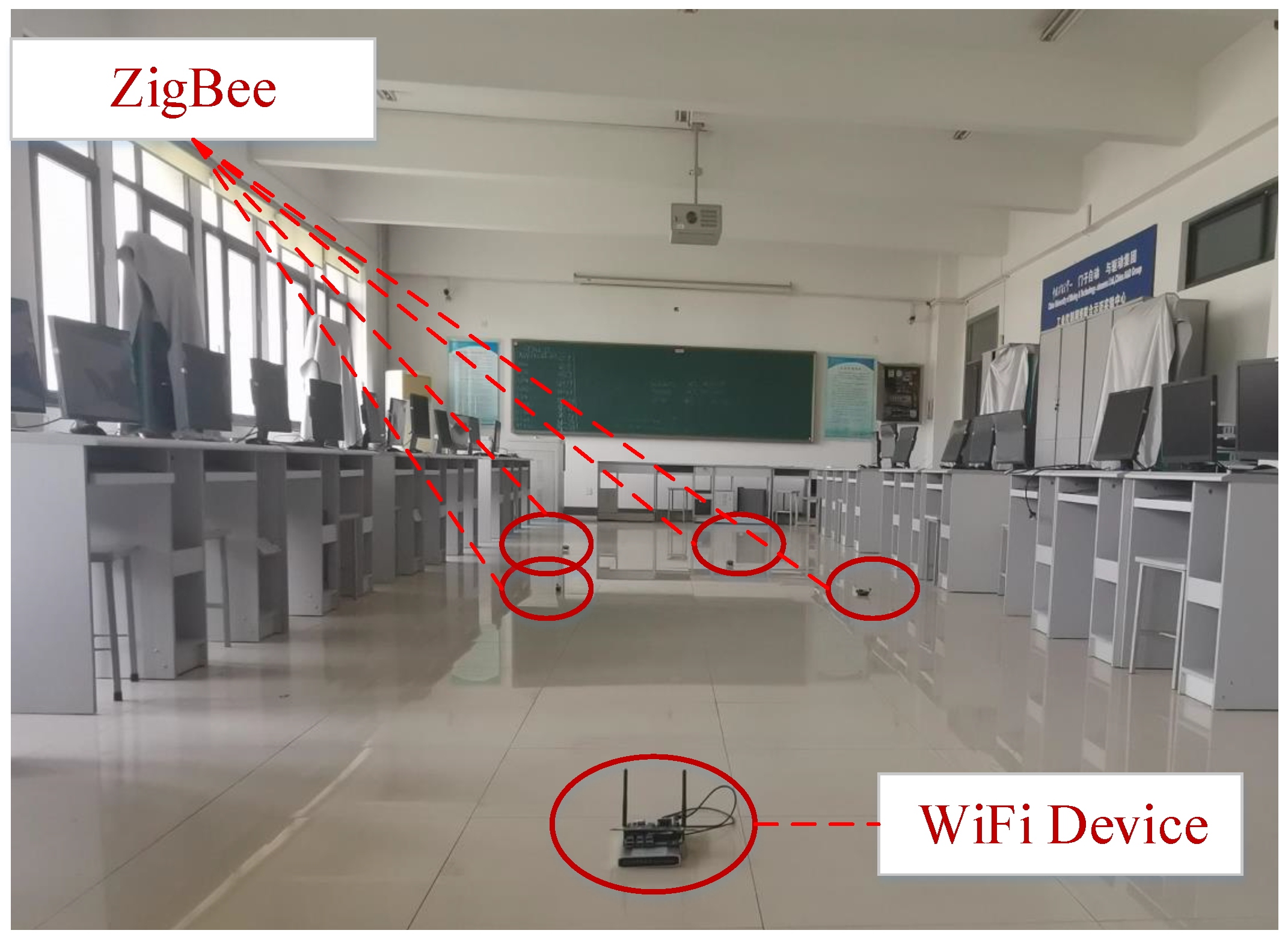

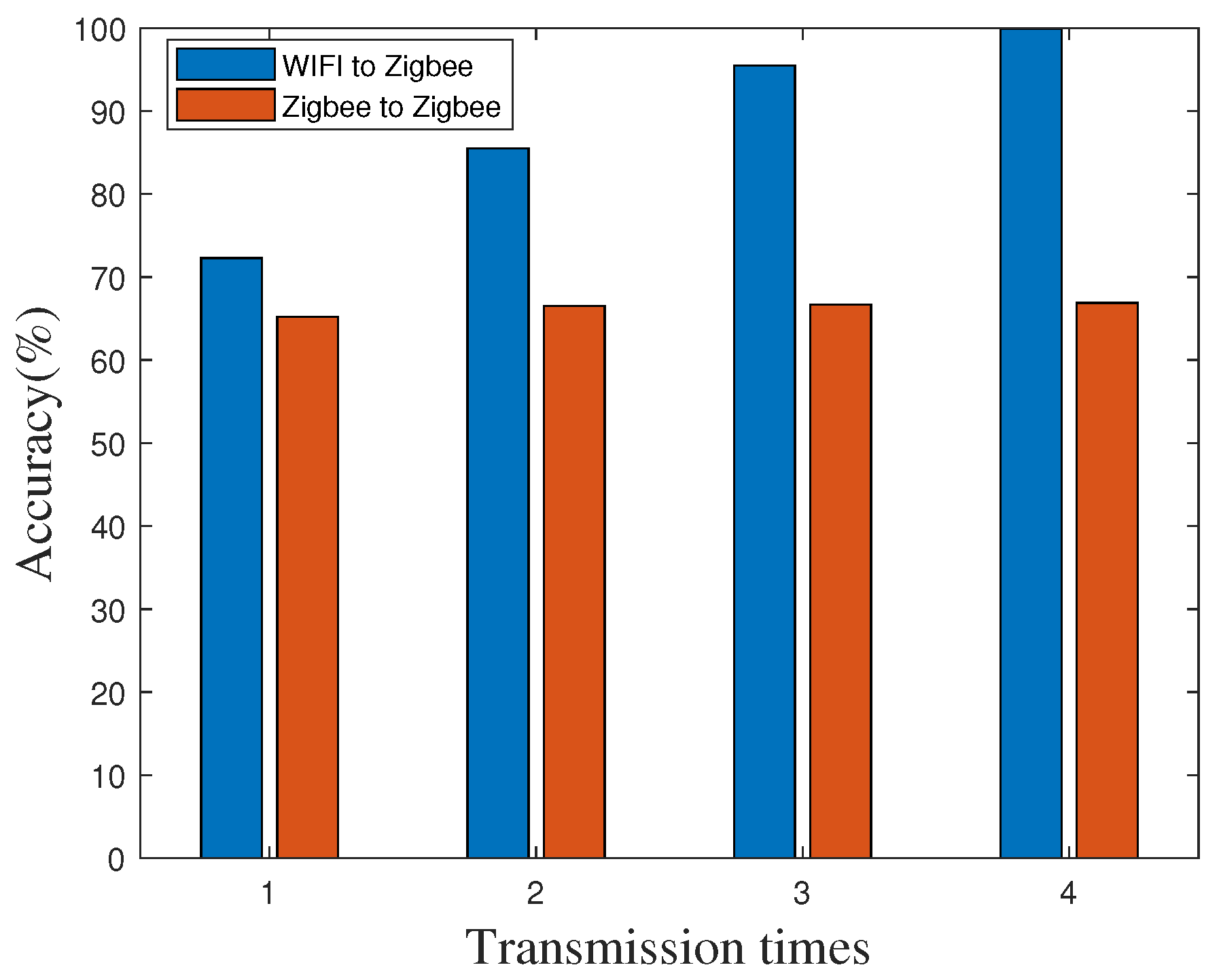
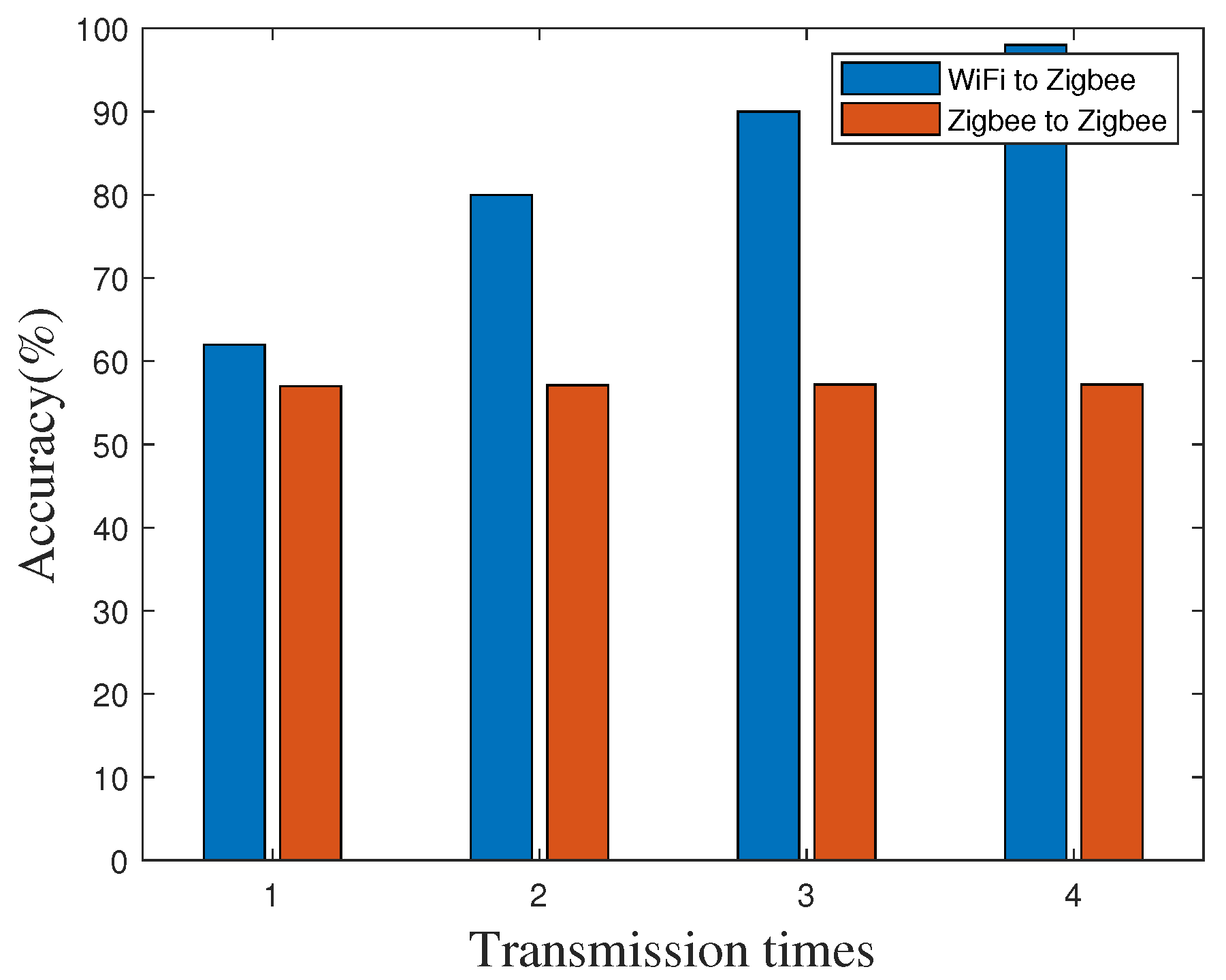
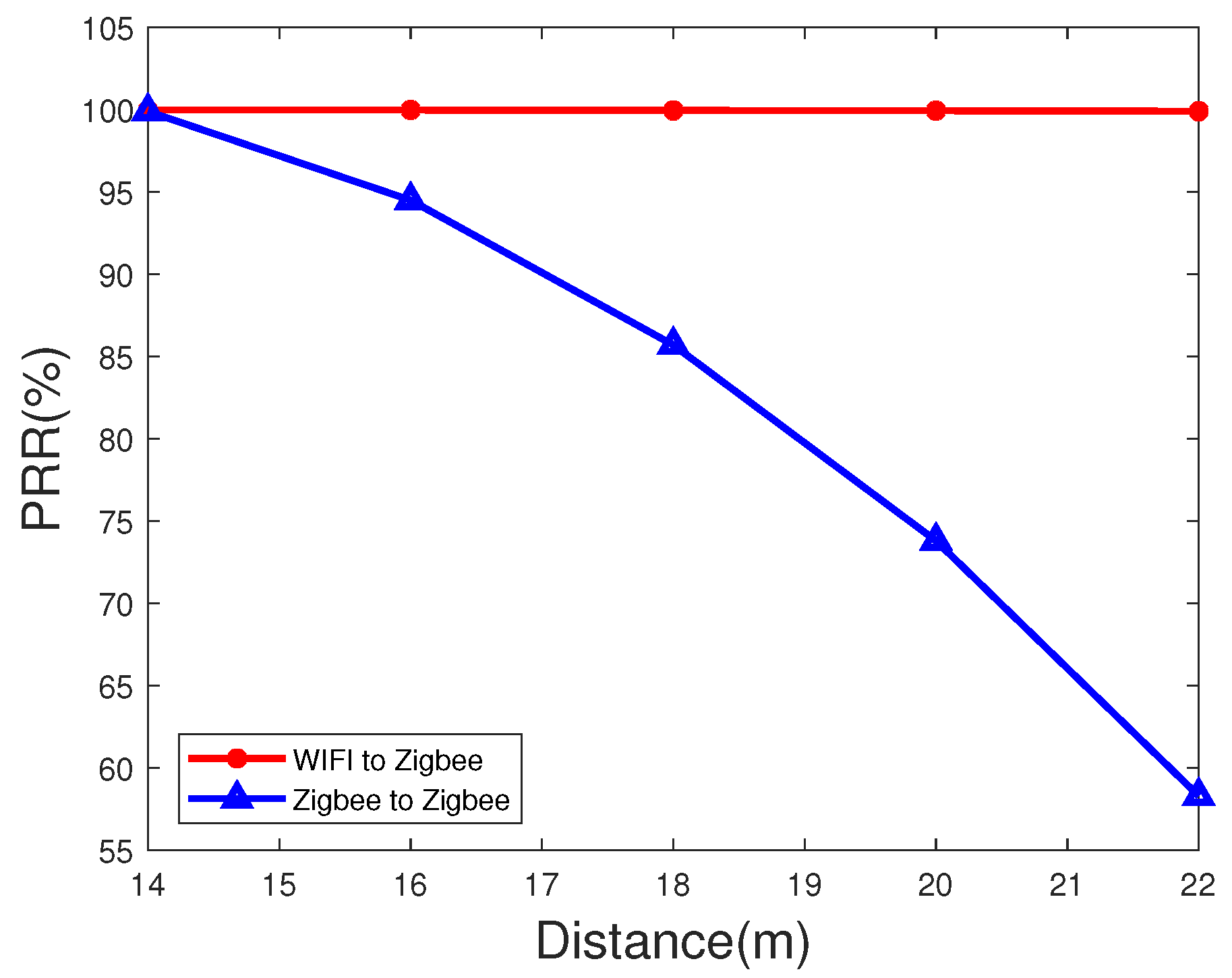
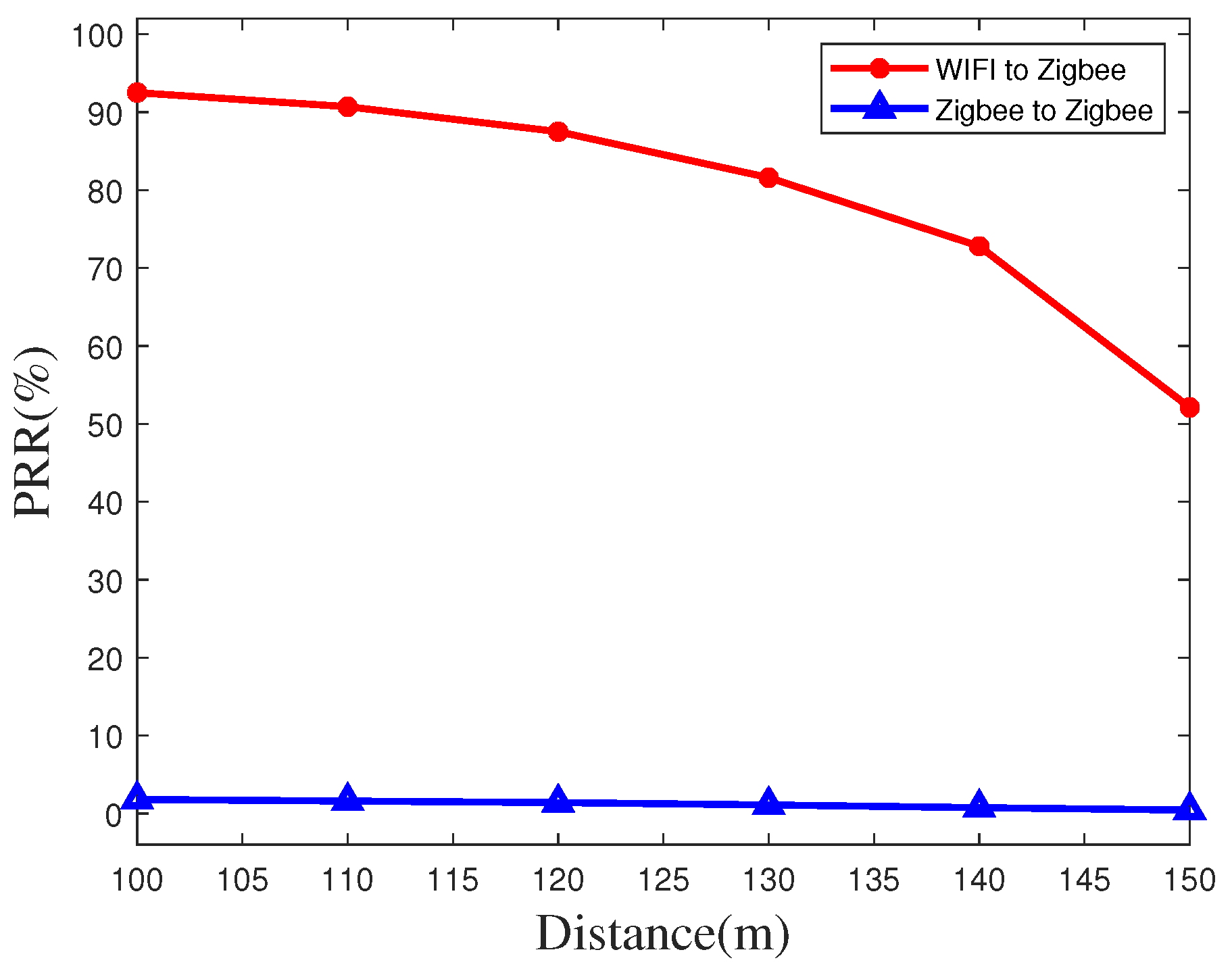
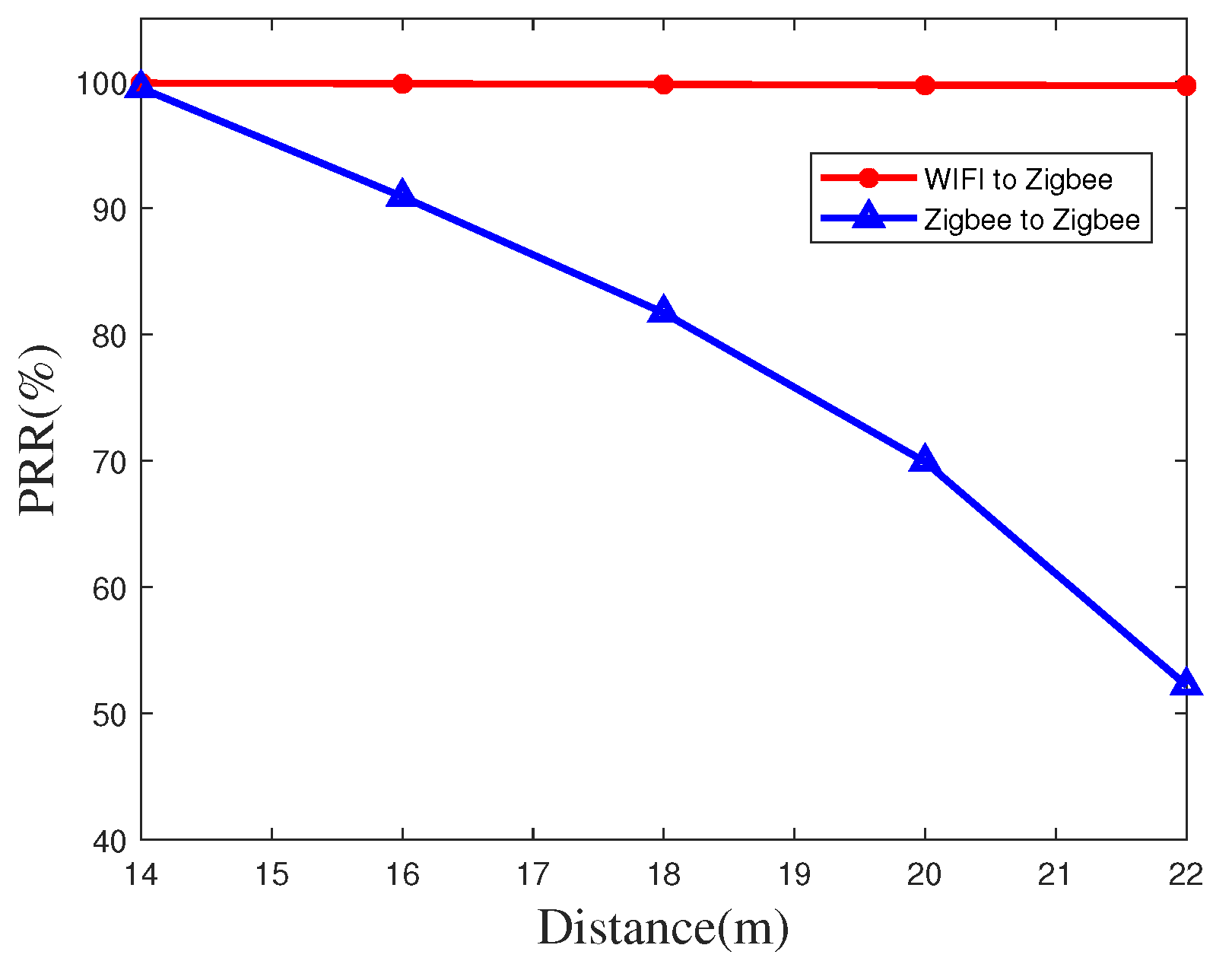
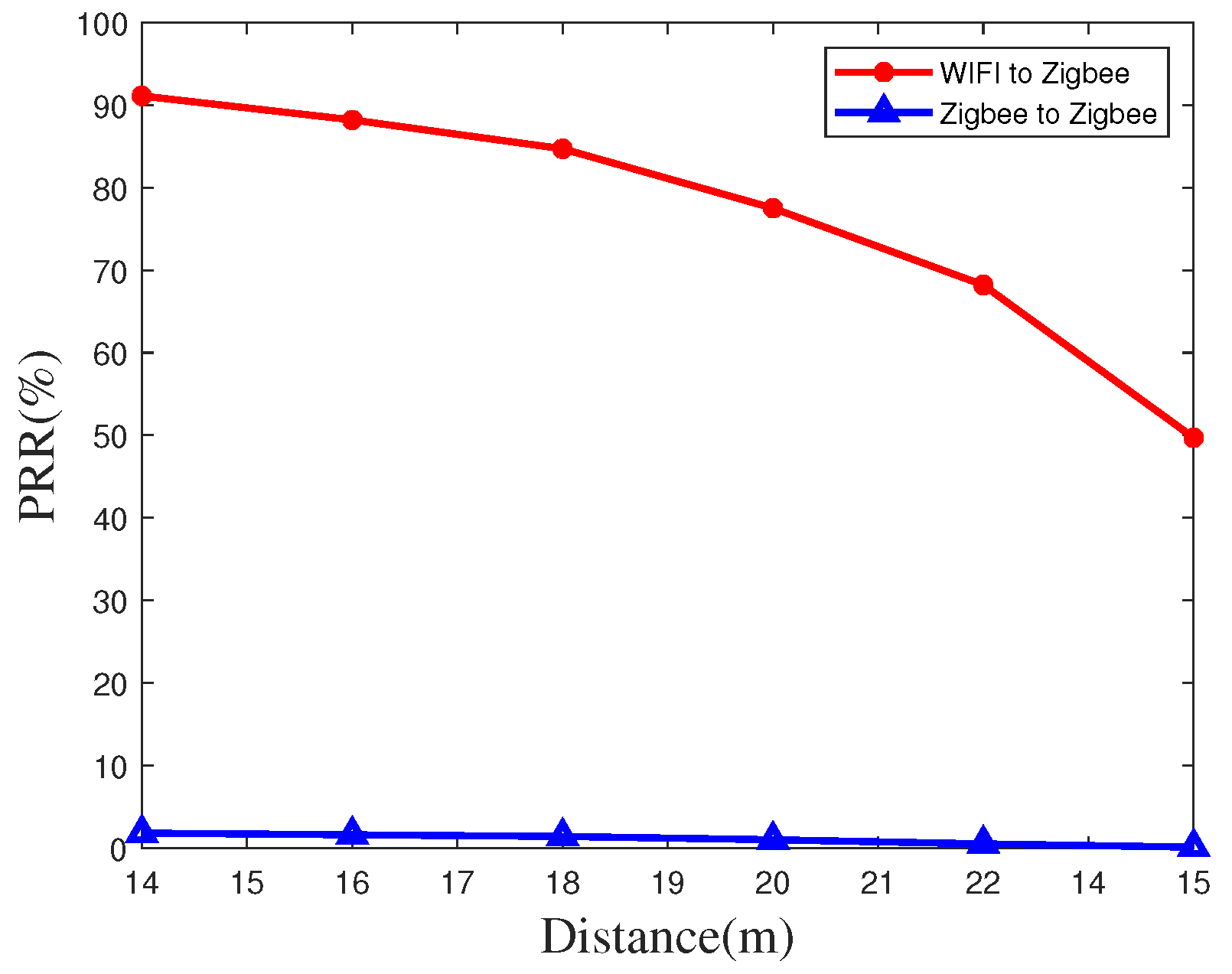

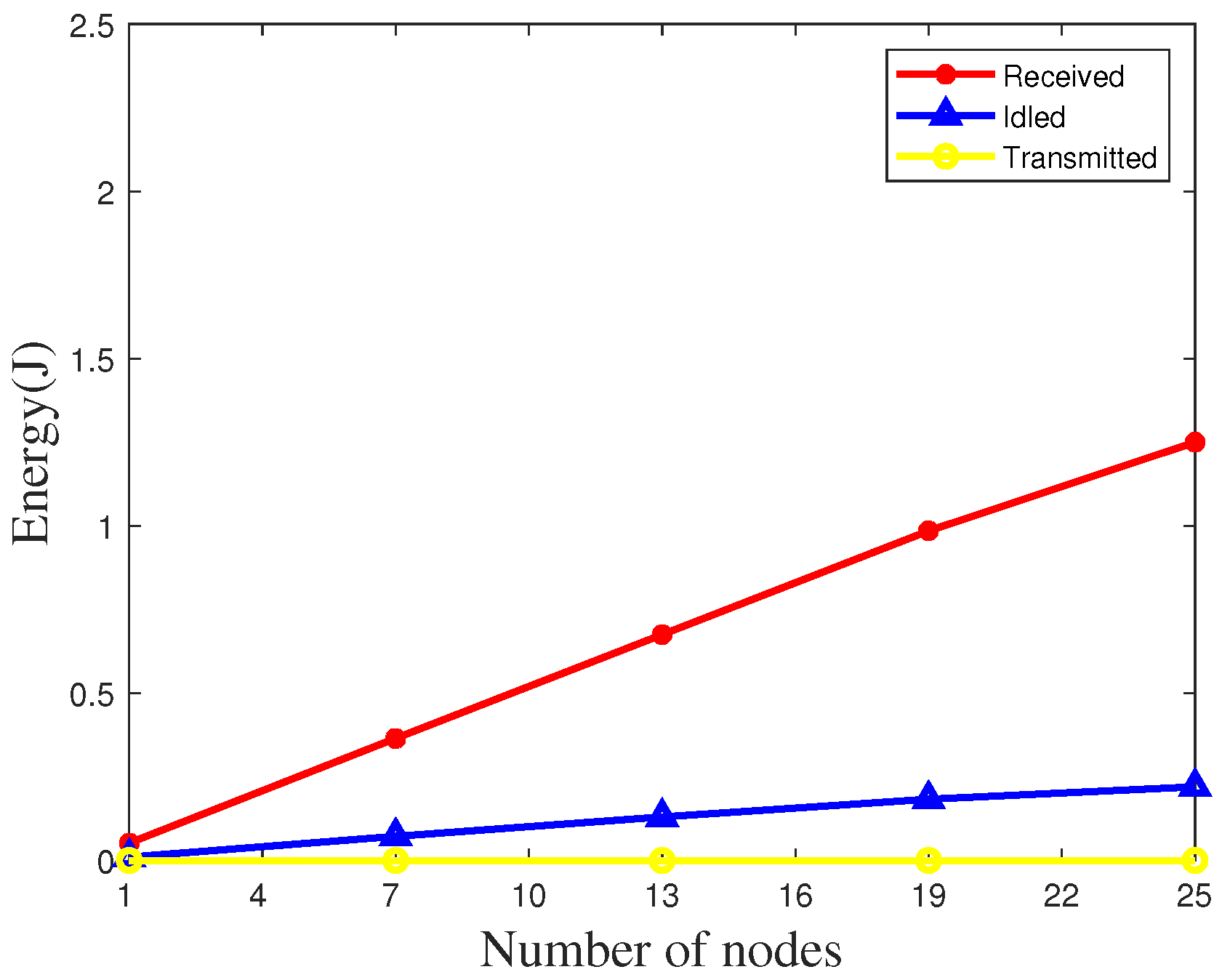

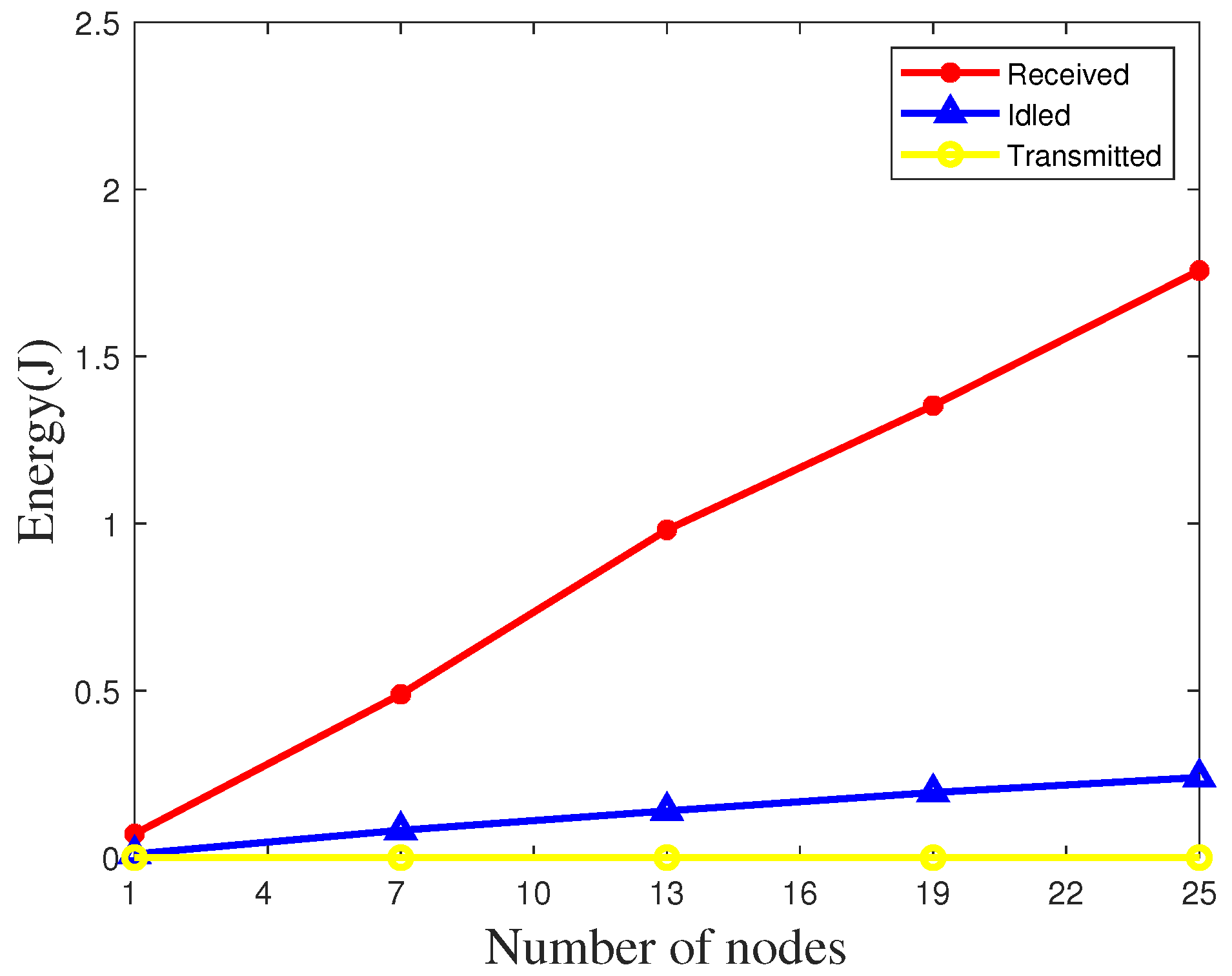

© 2020 by the authors. Licensee MDPI, Basel, Switzerland. This article is an open access article distributed under the terms and conditions of the Creative Commons Attribution (CC BY) license (http://creativecommons.org/licenses/by/4.0/).
Share and Cite
Tan, Z.; Yang, X.; Pang, M.; Gao, S.; Li, M.; Chen, P. UAV-Assisted Low-Consumption Time Synchronization Utilizing Cross-Technology Communication. Sensors 2020, 20, 5134. https://doi.org/10.3390/s20185134
Tan Z, Yang X, Pang M, Gao S, Li M, Chen P. UAV-Assisted Low-Consumption Time Synchronization Utilizing Cross-Technology Communication. Sensors. 2020; 20(18):5134. https://doi.org/10.3390/s20185134
Chicago/Turabian StyleTan, Ziyi, Xu Yang, Mingzhi Pang, Shouwan Gao, Ming Li, and Pengpeng Chen. 2020. "UAV-Assisted Low-Consumption Time Synchronization Utilizing Cross-Technology Communication" Sensors 20, no. 18: 5134. https://doi.org/10.3390/s20185134
APA StyleTan, Z., Yang, X., Pang, M., Gao, S., Li, M., & Chen, P. (2020). UAV-Assisted Low-Consumption Time Synchronization Utilizing Cross-Technology Communication. Sensors, 20(18), 5134. https://doi.org/10.3390/s20185134





